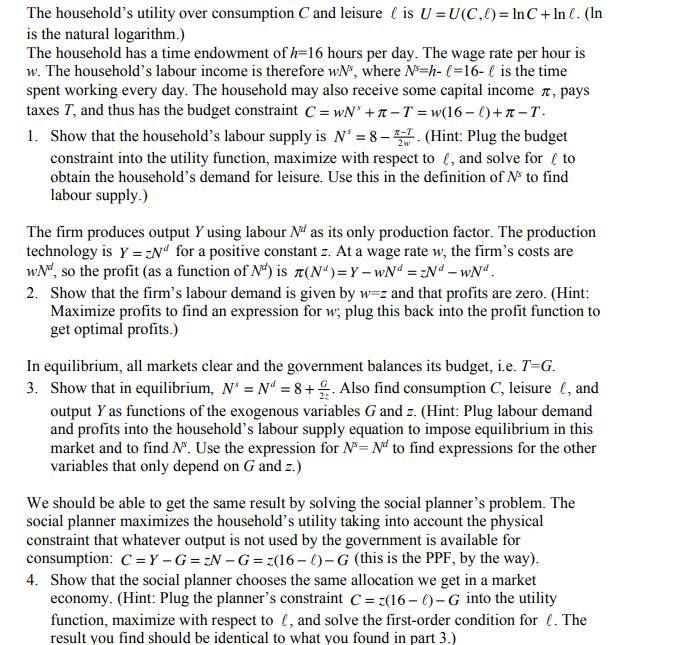Answered step by step
Verified Expert Solution
Question
1 Approved Answer
The household's utility over consumption C and leisure is U = U(C,0) = In C+In C. (In is the natural logarithm.) The household has

The household's utility over consumption C and leisure is U = U(C,0) = In C+In C. (In is the natural logarithm.) The household has a time endowment of h=16 hours per day. The wage rate per hour is w. The household's labour income is therefore wNs, where N=h- (-16-l is the time spent working every day. The household may also receive some capital income, pays taxes T, and thus has the budget constraint C = wN' +-T=w(16-0)+n-T. 1. Show that the household's labour supply is N=8-- (Hint: Plug the budget constraint into the utility function, maximize with respect to , and solve for to obtain the household's demand for leisure. Use this in the definition of N to find labour supply.) The firm produces output Y using labour Nd as its only production factor. The production technology is Y = ZN for a positive constant z. At a wage rate w, the firm's costs are wNd, so the profit (as a function of N) is (N) =Y-wNd =Nd-wNd 2. Show that the firm's labour demand is given by w-z and that profits are zero. (Hint: Maximize profits to find an expression for w; plug this back into the profit function to get optimal profits.) In equilibrium, all markets clear and the government balances its budget, i.e. T=G. 3. Show that in equilibrium, N = N = 8+. Also find consumption C, leisure, and output Y as functions of the exogenous variables G and z. (Hint: Plug labour demand and profits into the household's labour supply equation to impose equilibrium in this market and to find N. Use the expression for N= Nd to find expressions for the other variables that only depend on G and z.) We should be able to get the same result by solving the social planner's problem. The social planner maximizes the household's utility taking into account the physical constraint that whatever output is not used by the government is available for consumption: C=Y-G=N-G=(16-0)-G (this is the PPF, by the way). 4. Show that the social planner chooses the same allocation we get in a market economy. (Hint: Plug the planner's constraint C = z(16-0)-G into the utility function, maximize with respect to , and solve the first-order condition for . The result you find should be identical to what you found in part 3.)
Step by Step Solution
★★★★★
3.49 Rating (162 Votes )
There are 3 Steps involved in it
Step: 1
The detailed ...
Get Instant Access to Expert-Tailored Solutions
See step-by-step solutions with expert insights and AI powered tools for academic success
Step: 2

Step: 3

Ace Your Homework with AI
Get the answers you need in no time with our AI-driven, step-by-step assistance
Get Started


